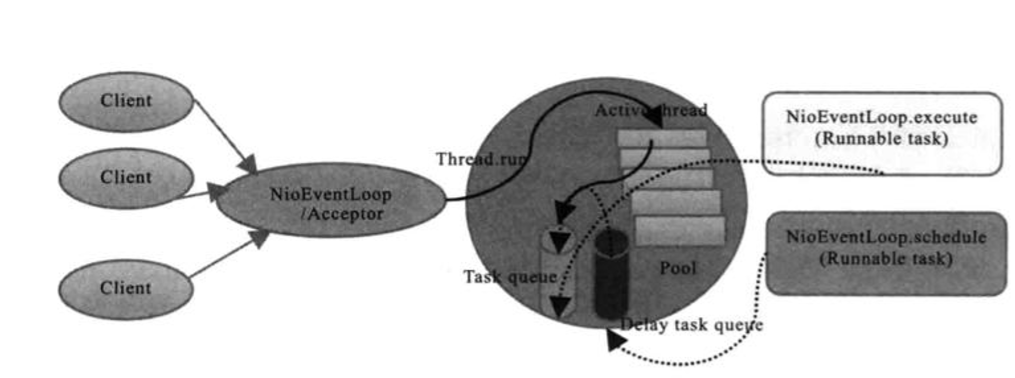Netty 是由 JBOSS 提供的一个 java 开源框架。Netty 提供异步的、事件驱动的网络应用 程序框架和工具,用以快速开发高性能、高可靠性的网络服务器和客户端程序。
也就是说,Netty 是一个基于 NIO 的客户、服务器端编程框架,使用 Netty 可以确保你 快速和简单的开发出一个网络应用,例如实现了某种协议的客户,服务端应用。Netty 相当 简化和流线化了网络应用的编程开发过程,例如,TCP 和 UDP 的 socket 服务开发。 “快速”和“简单”并不用产生维护性或性能上的问题。Netty 是一个吸收了多种协议的实 现经验,这些协议包括 FTP,SMTP,HTTP,各种二进制,文本协议,并经过相当精心设计的项 目,最终,Netty 成功的找到了一种方式,在保证易于开发的同时还保证了其应用的性能, 稳定性和伸缩性
在设计上:针对多种传输类型的统一接口 - 阻塞和非阻塞;简单但更强大的线程模型; 真正的无连接的数据报套接字支持;链接逻辑支持复用;
在性能上:比核心 Java API 更好的吞吐量,较低的延时;资源消耗更少,这个得益于 共享池和重用;减少内存拷贝 在健壮性上:消除由于慢,快,或重载连接产生的 OutOfMemoryError;消除经常发现 在 NIO 在高速网络中的应用中的不公平的读/写比 在安全上:完整的 SSL / TLS 和 StartTLS 的支持
Netty 的官网是:http://netty.io
有 三 方 提 供 的 中 文 翻 译 Netty 用 户 手 册 ( 官 网 提 供 源 信 息 ): http://ifeve.com/netty5-user-guide/
Netty 架构

代码:
/**
* 1. 双线程组
* 2. Bootstrap配置启动信息
* 3. 注册业务处理Handler
* 4. 绑定服务监听端口并启动服务
*/
import io.netty.bootstrap.ServerBootstrap;
import io.netty.channel.ChannelFuture;
import io.netty.channel.ChannelHandler;
import io.netty.channel.ChannelInitializer;
import io.netty.channel.ChannelOption;
import io.netty.channel.EventLoopGroup;
import io.netty.channel.nio.NioEventLoopGroup;
import io.netty.channel.socket.SocketChannel;
import io.netty.channel.socket.nio.NioServerSocketChannel;
public class Server4HelloWorld {
// 监听线程组,监听客户端请求
private EventLoopGroup acceptorGroup =null;
// 处理客户端相关操作线程组,负责处理与客户端的数据通讯
private EventLoopGroup clientGroup =null;
// 服务启动相关配置信息
private ServerBootstrap bootstrap =null;
public Server4HelloWorld(){
init();
}
private void init(){
// 初始化线程组,构建线程组的时候,如果不传递参数,则默认构建的线程组线程数是CPU核心数量。
acceptorGroup=new NioEventLoopGroup();
clientGroup=new NioEventLoopGroup();
// 初始化服务的配置
bootstrap=new ServerBootstrap();
// 绑定线程组
bootstrap.group(acceptorGroup,clientGroup);
// 设定通讯模式为NIO, 同步非阻塞
bootstrap.channel(NioServerSocketChannel.class);
// 设定缓冲区大小, 缓存区的单位是字节。
bootstrap.option(ChannelOption.SO_BACKLOG, 1024);
// SO_SNDBUF发送缓冲区,SO_RCVBUF接收缓冲区,SO_KEEPALIVE开启心跳监测(保证连接有效)
bootstrap.option(ChannelOption.SO_SNDBUF, 16*1024)
.option(ChannelOption.SO_RCVBUF, 16*1024)
.option(ChannelOption.SO_KEEPALIVE, true);
}
/**
* 监听处理逻辑。
* @param port 监听端口。
* @param acceptorHandlers 处理器, 如何处理客户端请求。
* @return
* @throws InterruptedException
*/
public ChannelFuture doAccept(int port,final ChannelHandler... acceptorHandlers)throws InterruptedException{
/*
* childHandler是服务的Bootstrap独有的方法。是用于提供处理对象的。
* 可以一次性增加若干个处理逻辑。是类似责任链模式的处理方式。
* 增加A,B两个处理逻辑,在处理客户端请求数据的时候,根据A-》B顺序依次处理。
*
* ChannelInitializer - 用于提供处理器的一个模型对象。
* 其中定义了一个方法,initChannel方法。
* 方法是用于初始化处理逻辑责任链条的。
* 可以保证服务端的Bootstrap只初始化一次处理器,尽量提供处理逻辑的重用。
* 避免反复的创建处理器对象。节约资源开销。
*/
bootstrap.childHandler(new ChannelInitializer<SocketChannel>(){
@Override
protected void initChannel(SocketChannel ch) throws Exception {
ch.pipeline().addLast(acceptorHandlers);
}
});
// bind方法 - 绑定监听端口的。ServerBootstrap可以绑定多个监听端口。 多次调用bind方法即可
// sync - 开始监听逻辑。 返回一个ChannelFuture。 返回结果代表的是监听成功后的一个对应的未来结果
// 可以使用ChannelFuture实现后续的服务器和客户端的交互。
ChannelFuture future = bootstrap.bind(port).sync();
return future;
}
/**
* shutdownGracefully - 方法是一个安全关闭的方法。可以保证不放弃任何一个已接收的客户端请求。
*/
public void release(){
this.acceptorGroup.shutdownGracefully();
this.clientGroup.shutdownGracefully();
}
public static void main(String[] args) {
ChannelFuture future = null;
Server4HelloWorld server = null;
try{
server = new Server4HelloWorld();
future = server.doAccept(9999,new Server4HelloWorldHandler());
System.out.println("server started.");
// 关闭连接的。
future.channel().closeFuture().sync();
}catch(InterruptedException e){
e.printStackTrace();
}finally{
if(null != future){
try {
future.channel().closeFuture().sync();
} catch (InterruptedException e) {
e.printStackTrace();
}
}
if(null != server){
server.release();
}
}
}
}
import io.netty.buffer.ByteBuf;
import io.netty.buffer.Unpooled;
import io.netty.channel.ChannelHandler.Sharable;
import io.netty.channel.ChannelHandlerAdapter;
import io.netty.channel.ChannelHandlerContext;
/**
* @Sharable注解 -
* 代表当前Handler是一个可以分享的处理器。也就意味着,服务器注册此Handler后,可以分享给多个客户端同时使用。
* 如果不使用注解描述类型,则每次客户端请求时,必须为客户端重新创建一个新的Handler对象。
* 如果handler是一个Sharable的,一定避免定义可写的实例变量。
* bootstrap.childHandler(new ChannelInitializer<SocketChannel>() {
@Override
protected void initChannel(SocketChannel ch) throws Exception {
ch.pipeline().addLast(new XxxHandler());
}
});
*/
@Sharable
public class Server4HelloWorldHandler extends ChannelHandlerAdapter{
/**
* 业务处理逻辑
* 用于处理读取数据请求的逻辑。
* ctx - 上下文对象。其中包含于客户端建立连接的所有资源。 如: 对应的Channel
* msg - 读取到的数据。 默认类型是ByteBuf,是Netty自定义的。是对ByteBuffer的封装。 不需要考虑复位问题。
*/
@Override
public void channelRead(ChannelHandlerContext ctx,Object msg) throws Exception{
// 获取读取的数据, 是一个缓冲。
ByteBuf readBuffer = (ByteBuf) msg;
// 创建一个字节数组,用于保存缓存中的数据。
byte[] tempDatas = new byte[readBuffer.readableBytes()];
// 将缓存中的数据读取到字节数组中。
readBuffer.readBytes(tempDatas);
String message = new String(tempDatas, "UTF-8");
System.out.println("from client : " + message);
if("exit".equals(message)){
ctx.close();
return;
}
String line = "server message to client!";
// 写操作自动释放缓存,避免内存溢出问题。
ctx.writeAndFlush(Unpooled.copiedBuffer(line.getBytes("UTF-8")));
// 注意,如果调用的是write方法。不会刷新缓存,缓存中的数据不会发送到客户端,必须再次调用flush方法才行。
// ctx.write(Unpooled.copiedBuffer(line.getBytes("UTF-8")));
// ctx.flush();
}
/**
* 异常处理逻辑, 当客户端异常退出的时候,也会运行。
* ChannelHandlerContext关闭,也代表当前与客户端连接的资源关闭。
*/
@Override
public void exceptionCaught(ChannelHandlerContext ctx,Throwable cause) throws Exception{
System.out.println("server exceptionCaught method run...");
// cause.printStackTrace();
ctx.close();
}
}
import java.util.Scanner;
import java.util.concurrent.TimeUnit;
import io.netty.bootstrap.Bootstrap;
import io.netty.buffer.Unpooled;
import io.netty.channel.ChannelFuture;
import io.netty.channel.ChannelFutureListener;
import io.netty.channel.ChannelHandler;
import io.netty.channel.ChannelInitializer;
import io.netty.channel.EventLoopGroup;
import io.netty.channel.nio.NioEventLoopGroup;
import io.netty.channel.socket.SocketChannel;
import io.netty.channel.socket.nio.NioSocketChannel;
/**
* 1. 单线程组
* 2. Bootstrap配置启动信息
* 3. 注册业务处理Handler
* 4. connect连接服务,并发起请求
*/
/**
* 因为客户端是请求的发起者,不需要监听。
* 只需要定义唯一的一个线程组即可。
*/
public class Client4HelloWorld {
// 处理请求和处理服务端响应的线程组
private EventLoopGroup group=null;
// 客户端启动相关配置信息
private Bootstrap bootstrap =null;
public Client4HelloWorld(){
init();
}
private void init(){
group=new NioEventLoopGroup();
bootstrap = new Bootstrap();
// 绑定线程组
bootstrap.group(group);
// 设定通讯模式为NIO
bootstrap.channel(NioSocketChannel.class);
}
public ChannelFuture doRequest(String host,int port,final ChannelHandler... handlers) throws InterruptedException{
/*
* 客户端的Bootstrap没有childHandler方法。只有handler方法。
* 方法含义等同ServerBootstrap中的childHandler
* 在客户端必须绑定处理器,也就是必须调用handler方法。
* 服务器必须绑定处理器,必须调用childHandler方法。
*/
this.bootstrap.handler(new ChannelInitializer<SocketChannel>(){
@Override
protected void initChannel(SocketChannel ch) throws Exception{
ch.pipeline().addLast(handlers);
}
});
// 建立连接。
ChannelFuture future =this.bootstrap.connect(host,port).sync();
return future;
}
public void release(){
this.group.shutdownGracefully();
}
public static void main(String[] args) {
Client4HelloWorld client = null;
ChannelFuture future = null;
try {
client = new Client4HelloWorld();
future = client.doRequest("localhost", 9999, new Client4HelloWorldHandler());
Scanner s = null;
while(true){
s = new Scanner(System.in);
System.out.print("enter message send to server (enter 'exit' for close client) > ");
String line = s.nextLine();
if("exit".equals(line)){
// addListener - 增加监听,当某条件满足的时候,触发监听器。
// ChannelFutureListener.CLOSE - 关闭监听器,代表ChannelFuture执行返回后,关闭连接。
future.channel().writeAndFlush(Unpooled.copiedBuffer(line.getBytes("UTF-8")))
.addListener(ChannelFutureListener.CLOSE);
break;
}
future.channel().writeAndFlush(Unpooled.copiedBuffer(line.getBytes("UTF-8")));
TimeUnit.SECONDS.sleep(1);
}
} catch(Exception e){
e.printStackTrace();
}finally{
if(null != future){
try {
future.channel().closeFuture().sync();
} catch (InterruptedException e) {
e.printStackTrace();
}
}
if(null != client){
client.release();
}
}
}
}
import io.netty.buffer.ByteBuf;
import io.netty.channel.ChannelHandlerAdapter;
import io.netty.channel.ChannelHandlerContext;
import io.netty.util.ReferenceCountUtil;
public class Client4HelloWorldHandler extends ChannelHandlerAdapter {
@Override
public void channelRead(ChannelHandlerContext ctx, Object msg) throws Exception {
try{
ByteBuf readBuffer = (ByteBuf) msg;
byte[] tempDatas = new byte[readBuffer.readableBytes()];
readBuffer.readBytes(tempDatas);
System.out.println("from server : " + new String(tempDatas, "UTF-8"));
}finally{
// 用于释放缓存。避免内存溢出
ReferenceCountUtil.release(msg);
}
}
@Override
public void exceptionCaught(ChannelHandlerContext ctx, Throwable cause) throws Exception {
System.out.println("client exceptionCaught method run...");
// cause.printStackTrace();
ctx.close();
}
/*@Override // 断开连接时执行
public void channelInactive(ChannelHandlerContext ctx) throws Exception {
System.out.println("channelInactive method run...");
}
@Override // 连接通道建立成功时执行
public void channelActive(ChannelHandlerContext ctx) throws Exception {
System.out.println("channelActive method run...");
}
@Override // 每次读取完成时执行
public void channelReadComplete(ChannelHandlerContext ctx) throws Exception {
System.out.println("channelReadComplete method run...");
}*/
}
线程模型

Netty 中支持单线程模型,多线程模型,主从多线程模型。
单线程模型
在 ServerBootstrap 调用方法 group 的时候,传递的参数是同一个线程组,且在构造线程 组的时候,构造参数为 1,这种开发方式,就是一个单线程模型。
个人机开发测试使用。不推荐
多线程模型
在 ServerBootstrap 调用方法 group 的时候,传递的参数是两个不同的线程组。负责监听 的 acceptor 线程组,线程数为 1,也就是构造参数为 1。负责处理客户端任务的线程组,线 程数大于 1,也就是构造参数大于 1。这种开发方式,就是多线程模型。 长连接,且客户端数量较少,连接持续时间较长情况下使用。如:企业内部交流应用。
主从多线程模型
在 ServerBootstrap 调用方法 group 的时候,传递的参数是两个不同的线程组。负责监听 的 acceptor 线程组,线程数大于 1,也就是构造参数大于 1。负责处理客户端任务的线程组, 线程数大于 1,也就是构造参数大于 1。这种开发方式,就是主从多线程模型。 长连接,客户端数量相对较多,连接持续时间比较长的情况下使用。如:对外提供服务 的相册服务器。